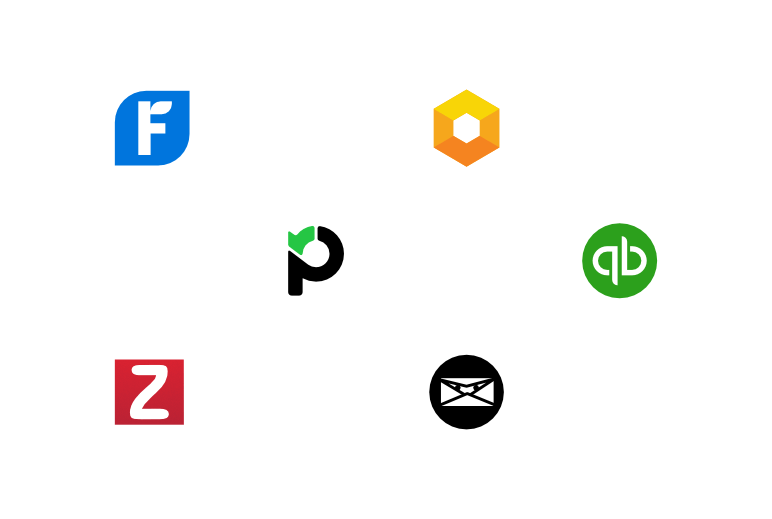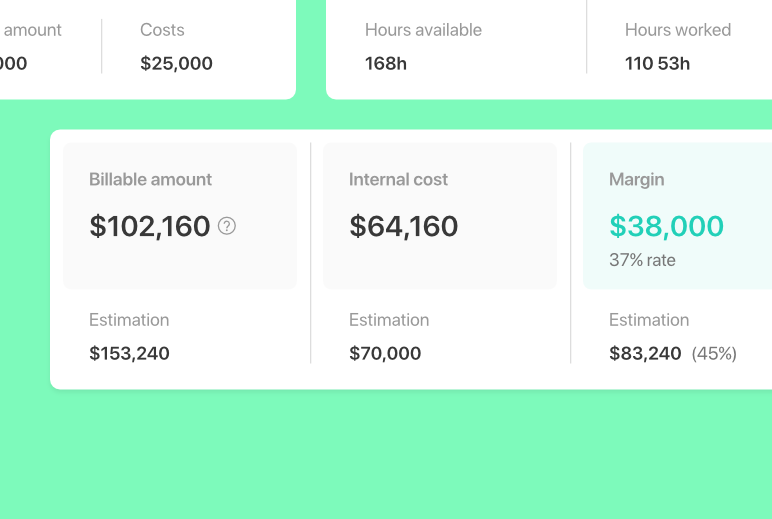As more organizations recognize this distinction, there’s a growing need for software tailored to meet these specific challenges.
Did you know that despite being aware of its benefits, only 1 in 4 companies use dedicated project management software?
Dive into our curated list of the top 20+ creative project management software designed to empower and streamline your artistic projects and foster inspired collaboration among teams.
Check this case study to see how project management software can really help a creative agency.
Whether you’re looking to visualize your next campaign, gather feedback on a design, or manage the ebb and flow of creative resources, we’ve got you covered.
Here are the best creative project management software:
- Paymo – best for small businesses, stellar time tracking & invoicing
- Monday – customizable platform tailored for niche creative team needs
- Simplified – ideal for creative teams who automate their work using AI templates
- Asana – lots of features, best for tech-friendly creative teams
- ClickUp – for creative teams that often encounter varied project requests
- Trello – for those who like Kanban boards
- Hive – for creative teams who need improved automation in management
- Wrike – many features, good customization, high focus on task manipulation
- Basecamp – ideal for creative teams who need a forum-like workspace
- Ntask – affordable and suitable for teams with limited budgets
- Teamwork – for creative teams that need good time tracking and task management
- Smartsheet – ideal for creative teams with an Excel background
Top 12 project management software for creatives
91
of 100
Pros
advanced time-tracking features
one-click invoicing based on timesheets
strong task management features
reliable support team
Cons
lacks native communication features
fewer integrations than other competitors
89
of 100
Pros
bright colors & clean design; the interface is aesthetically pleasing for many
more intuitive compared to other apps, though not the easiest to use
high customization options cater to specific needs
features automations, which most tools lack
Cons
the high price point may be a concern for individuals and small businesses
live chat functionality is not very reliable
the mobile app tends to be slow and clunky
the notification system can be confusing
87
of 100
Pros
intuitive design and easy-to-use drag-and-drop functionality
allows assigning tasks to multiple team members, ensuring seamless teamwork
provides up-to-date status on tasks, helping to keep the team aligned
syncs with popular tools like Google Drive and Slack, maintaining a smooth workflow
adaptable to different project types and team needs
Cons
might take some time for new users to fully explore and utilize all features
may lack some advanced features found in other, more complex project management tools
cluttered interface for large projects
advanced features require a premium subscription
86
of 100
Pros
easy to use, intuitive
aesthetically pleasing
many customization features
unicorn graphic that appears when you complete a task
many integrations with other tools
Cons
expensive when compared to other tools
the notification system is confusing
one assignee per task
85
of 100
Pros
feature-rich with regular additions
highly adaptable with versatile applications across various scenarios
responsive support team
advanced automation capabilities
frequent updates ensuring up-to-date functionality
Cons
it can be overwhelming due to its many features, posing a steep learning curve
less intuitive and user-friendly, leading to potential confusion
occasionally sluggish performance with occasional server downtimes
some reported bugs, UI challenges, and automation hiccups
pricing can be deceptive; initial costs seem affordable, but expenses can accumulate swiftly
82
of 100
Pros
Trello excels at managing tiny projects and personal tasks
ideal for Kanban enthusiasts, offering a visual flow of creative tasks
intuitive drag-and-drop interface perfect for designers, writers, and creatives
Cons
limited advanced features such as Gantt charts, time tracking, and documentation
it can become restrictive and cluttered for larger teams or those managing hundreds of projects.
while appealing to beginners, its simplicity may lead to an overwhelming number of boards and projects
81
of 100
Pros
suited for creative teams handling multiple projects
streamlines processes with its automation capabilities
Cons
pricing starts higher than some other comparable tools
costs can rise quickly due to the add-on system
it may work slowly sometimes.
79
of 100
Pros
many customization options & high flexibility
extensive features
dependent tasks and advanced task functions
project templates
Cons
setup complexity
steep learning curve
notifications overload
customer service issues
generic support responses
78
of 100
Pros
centralized platform to share files, chat, and assign tasks
clean UI; the dashboard looks and feels like a forum
visualization features like ‘Lineup’ (Timeline) or ‘Card Table’ (Kanban)
‘Focus mode’ that mutes notifications
Cons
limited project management features
lack of robust customization options for workflows; Kanban cannot be customized
prices make sense only for large creative teams (over 30 users)
76
of 100
Pros
cost-effective for entry-level project management
responsive and efficient support team
Cons
occasional lag or slow responsiveness
mobile app receives mixed reviews from users
limited features
enhancements are needed, especially for Gantt charts
steep learning curve
hard to customize
75
of 100
Pros
it offers a vast array of features
a comprehensive suite of functionalities for project management
excellent for dynamic task management
the time tracking feature is highly praised
dashboards provide a clear overview of projects, workload, and team capacity
Cons
it might be slower than other apps
can become unresponsive at times
steeper learning curve for new users
some users find the system disjointed
72
of 100
Pros
ideal for those with an Excel background, capitalizing on their existing skills
the transition from Excel to SmartSheet is intuitive for many due to its familiar features
it offers enhanced functionalities beyond Excel.
Cons
transition can be challenging for those unfamiliar with Excel
there are significant differences between Excel and SmartSheet, causing disorientation
not all Excel formulas and features have counterparts in SmartSheet
file uploading from Excel to SmartSheet can cause formatting issues.
SmartSheet may not recognize or interpret specific Excel-specific formulas
SmartSheet lacks some keyboard shortcuts familiar to Excel users
the interface can be less intuitive for complex project management requirements, leading some to prefer simpler platforms
Alternatives worth considering
13. FunctionFox
FunctionFox shares similarities with Paymo, boasting features explicitly tailored for time tracking and billing.
These functionalities are crucial for creative teams, ensuring precise time logs and accurate client billing. If, for any reason, Paymo doesn’t resonate with your needs, FunctionFox stands as a commendable alternative worth exploring.
14. Redbooth
From the perspective of a creative team, Redbooth seems more user-friendly than many other project management tools we’ve explored. Its intuitive design makes it simple to navigate and utilize.
Features like real-time editing and task chats distinguish Redbooth from the crowd.
Additionally, having a straightforward mobile app is a plus when we need to work remotely or while traveling.
When it comes to cost, their pricing doesn’t make things complicated, which is a relief. Comparatively, when we looked into Wrike, there was a bit of a hiccup since you need to commit to a minimum of five licenses. That’s not always ideal, especially for smaller teams or startups that may not require that many seats initially.
On the other hand, ClickUp has a lot going for it, but some features we deemed essential were tucked away in their business or enterprise tiers. This can pose challenges for teams needing those features but not necessarily have the budget or scale to jump into a higher pricing bracket.
15. ActiveCollab
ActiveCollab blends simplicity with robust features, offering an intuitive interface that prioritizes ease of use without sacrificing depth. While rich in functionalities comparable to tools like Clickup, it limits customizability to maintain user-friendliness. Its design balances a clean, minimalist appearance and a robust backend.
While its interface is user-friendly, it doesn’t offer extensive personalization. This can be a drawback for those who value tailored aesthetics or need flexibility for complex team workflows and unique operational challenges.
ActiveCollab’s task management can present hurdles for intricate assignments and overlapping team roles in a creative team setting.
A task can only be designated to one individual, even though others can observe as watchers. This limitation is problematic for tasks that demand input from multiple contributors and is further compounded by subtasks needing individual due dates.
Consequently, tasks undergo regular reassignments and due date modifications, which introduces unnecessary manual management in what should be an efficient project management system.
Check this detailed ActiveCollab review to help you form an informed opinion before trying it out.
16. Notion
Notion’s strength lies in its custom databases, allowing teams to store diverse and intricate information tailored to their unique needs. This means creative teams aren’t just limited to simple task lists; they can architect detailed databases to capture every nuance of a project.
For instance, a creative team could design a database to track video projects, embedding columns for stages like “Storyboarding,” “Filming,” or “Post-production,” and further customizing each entry with details like shoot locations, talent involved, and feedback loops.
By customizing their view, teams can ensure they’re looking at what matters most to them, allowing for a more efficient and personalized workflow.
17. Flow
Flow presents a visually appealing interface that promises functionality and an enjoyable experience as you interact with the app. Even stacked against big names like Asana, its user experience shines.
Ensuring a tool is visually attractive is key when rallying a team around it. Beyond its aesthetic allure, Flow stands out with its clear, user-friendly design that can be adapted to meet specific demands, distinguishing it from the crowded space of project management tools.
While Flow offers many benefits, it has its limitations. One glaring omission is its lack of built-in time-tracking features. This can be a significant hindrance for businesses that rely on monitoring the duration spent on particular tasks or entire projects.
Time tracking ensures that resources are judiciously utilized and billing for client projects is accurate. Taking the example of a graphic design agency, understanding the hours dedicated to a specific design not only aids in billing clients accurately but also helps assess the efficiency of their design team.
Consider alternatives if having time tracking seamlessly integrated into your project management tool is non-negotiable. Paymo, for instance, brings robust time-tracking features to the table, making it a viable alternative to Flow in such scenarios.
18. ProProfs
Its unique pricing model sets Proprofs Project apart in the crowded landscape of project management tools. Instead of charging per user or feature, it has a single flat fee of 49.97, giving you access to unlimited users and functionalities.
This model benefits large creative teams, as costs can escalate quickly with other pricing structures. It’s an ideal way to experiment with a project management solution without the financial strain.
When contrasted with Wrike, there’s no need to purchase user packs as your team expands. Likewise, you won’t find yourself dipping into your pockets for add-ons, as you might with Hive, or paying extra for features deemed “advanced” or “enterprise-level,” as with ClickUp.
Additionally, the flat fee for the Proprofs Project is surprisingly affordable. The cost is comparable to what many platforms charge for just a handful of users. So, you get the advantage of unlimited users and features at a price equivalent to basic packages on other platforms. It offers remarkable value, especially for larger teams looking to dip their toes into project management.
19. Scoro
From a creative team’s viewpoint, its robust quoting feature distinguishes Scoro from other tools. Scoro’s integrated quoting tool streamlines the process of drafting and sending quotes to clients.
With seamless integration with other Scoro features, it’s effortless to incorporate project specifics, monitor time and resources, and transform quotes directly into projects. This proves invaluable for creative teams often juggling numerous quotes and proposals. Moreover, the tool can be tailored to mirror our branding, ensuring each quote looks professional and aligns with our identity.
Some drawbacks of Scoro include its pricing structure, which is on the higher side. The cost escalates to access most of its features, making it potentially prohibitive for smaller companies, especially those primarily interested in time logging. In that case, Paymo is a more suitable and cost-effective alternative, especially for smaller companies or those on a tighter budget.
20. Planview (Clarizen)
Planview’s OKR feature offers a roadmap for creative teams, turning abstract ideas into measurable results and aligning projects with overarching objectives.
Planview’s “Objectives & Key Results” (OKR) feature simplifies strategy management. You set big goals (objectives) and then define measurable steps (key results) to achieve them.
Each key result can be linked to specific projects, letting teams see how they progress toward more significant objectives. This means, at any point, you can see how your projects are directly helping achieve the team’s primary goals. If things go off-track, adjustments can be made. Plus, you can measure the real-world impact of your projects.
Several project management tools, like Wrike and Asana, offer features similar to Planview’s OKR for strategy management. While Wrike labels it “Company Goals” and Asana as “Strategic Roadmaps,” they all aim to connect projects with strategic objectives. However, Planview’s OKR is often considered one of the most thorough in the field.
21. Podio
Podio differentiates itself from other project management tools with its strong emphasis on workflow automation. This proves particularly beneficial for creative teams. Take a design project within Podio, for instance:
Once a piece is ready, you can initiate a workflow that instantly forwards the design to multiple stakeholders for their input. Reminders or notifications can be sent out if feedback isn’t received within a set timeframe. Once greenlit, the workflow can generate a new task, signaling the production team to commence. This automation ensures a smooth, uninterrupted creative journey, minimizing manual oversight.
Podio and Hive both help with automation but in different ways. While Hive’s setup for workflows is more straightforward and offers more pre-made options, Podio’s setup is trickier for newcomers.
However, Podio offers more depth, allowing for intricate workflows with advanced data and logic features.
Key decision factors when choosing the best creative project management software
Choosing the right creative project management software can significantly influence your projects’ success and your team’s efficiency. Here are some key decision factors I took into account when considering which tools to recommend:
- Time-tracking features are vital for creative teams because they ensure accurate client billing, optimize resource allocation, provide insights into project efficiency, and aid in evaluating team productivity. For instance, a design studio can accurately bill clients for hours spent on the artwork, assess which phases consume the most time, and adjust workflows or resources for future projects.
- Invoicing features. Consider a creative agency working on multiple campaigns. After finalizing a video advertisement for a client, the team can immediately generate an invoice within the same PM tool, factoring in the hours logged, any additional expenses incurred, and any pre-agreed rates or discounts. This ensures that billing is timely and reflects the actual work done, and the agency can maintain a steady cash flow without delays.
- Visualization options: Kanban, Gantt chart. Kanban boards track task progression for a creative agency, while Gantt charts visualize project timelines and dependencies, ensuring efficient workflow, deadline adherence, and optimal resource allocation. For example, in a creative agency developing a marketing campaign, a Kanban board might be used to track the creation of different campaign elements (like graphics, video content, and copywriting). Each element moves through stages, from ideation to approval. Simultaneously, a Gantt chart could outline the entire campaign timeline, showing when the video shoot needs to be completed to allow time for post-production before the campaign launch. If the video shoot is delayed, the Gantt chart would visually indicate how this delay might affect subsequent tasks and the final launch date.
- Collaboration and communication features. For a creative team, collaboration and communication tools streamline interactions and unify visions. For example, during a website redesign, integrated chat and annotation features can allow a graphic artist, developer, and client to align on changes instantly, reducing iterations and ensuring the final output meets expectations.
- Customizable dashboards allow for a tailored view of project data, aligning with the unique needs and workflows of the creative process. By personalizing dashboards, teams can prioritize information, quickly access relevant details, and monitor key metrics, ensuring that the team remains focused on essential tasks while fostering creativity. For example, a video production team might prioritize timelines and asset tracking on their dashboard, while a graphic design team may emphasize feedback loops and revision histories.
- Task & milestone tracking is essential for creative teams because they provide a structured framework in an often fluid and dynamic creative process. They ensure that projects progress on schedule, help align various creative elements towards a unified goal, and offer clarity about individual responsibilities. For instance, when producing a film, tracking tasks ensures that scriptwriting, casting, filming, and post-production happen sequentially, while milestones like “principal photography completion” give a clear checkpoint, ensuring timely progress and alignment of the entire team.
- Ease of use/intuitiveness. When a tool is intuitive, team members can focus on their primary tasks – designing, writing, illustrating, etc. – rather than spending excessive time learning or troubleshooting the tool. In essence, an easy-to-use tool amplifies creativity by reducing unnecessary friction.
- Support & customer service. When issues arise, timely and effective support prevents prolonged downtimes and data loss, allowing the creative team to maintain momentum. Given the often tight deadlines and client expectations these teams face, any tool-related delay can have cascading effects.
- Feedback from other users is vital in a PM tool for creative teams because it offers real-world insights into the tool’s strengths, weaknesses, and potential issues. Such feedback can guide a team in understanding how the tool fits within various creative workflows, what customization might be necessary, and how to avoid common pitfalls. Additionally, user feedback can highlight beneficial features or practices that the team might have yet to initially consider, optimizing the tool’s usage and the team’s overall productivity.
- Budget and Pricing are essential for smaller creative teams or those with fluctuating project demands; excessive costs can strain budgets and divert funds from other essential areas, such as talent acquisition or software upgrades. For example, suppose a small design agency allocates a disproportionate budget to an overly complex PM tool. In that case, it may lack the funds for designing software subscriptions or training sessions, compromising the quality of its output and the development of its team members.
- Integrations. The software must be able to connect with external applications, such as a CRM, a social media scheduler, an email marketing tool, and more.
Conclusion
The landscape of project management tools offers a rich array of options tailored to the specific needs of creative teams.
For small businesses, Paymo shines with its top-notch time tracking and invoicing. Monday allows niche customization, while Asana’s vast features cater to tech-savvy creative teams. Clickup addresses diverse project needs, and Trello is a haven for Kanban enthusiasts.
Hive significantly elevates automation capabilities, whereas Wrike emphasizes task manipulation with many features. For those familiar with Excel, Smartsheet offers a comfortable transition. Ntask is a budget-friendly choice, and Teamwork excels in time tracking and task management for creatives.
The best fit ultimately depends on each creative team’s unique requirements and workflow.

Laurențiu Bancu
Author
Laurențiu started his marketing journey over 18 years ago and now leads a marketing team. He has extensive experience in work and project management, and content strategy. When not working, he’s probably playing board games or binge-watching mini-series.

Alexandra Martin
Editor
Drawing from a background in cognitive linguistics and armed with 10+ years of content writing experience, Alexandra Martin combines her expertise with a newfound interest in productivity and project management. In her spare time, she dabbles in all things creative.













